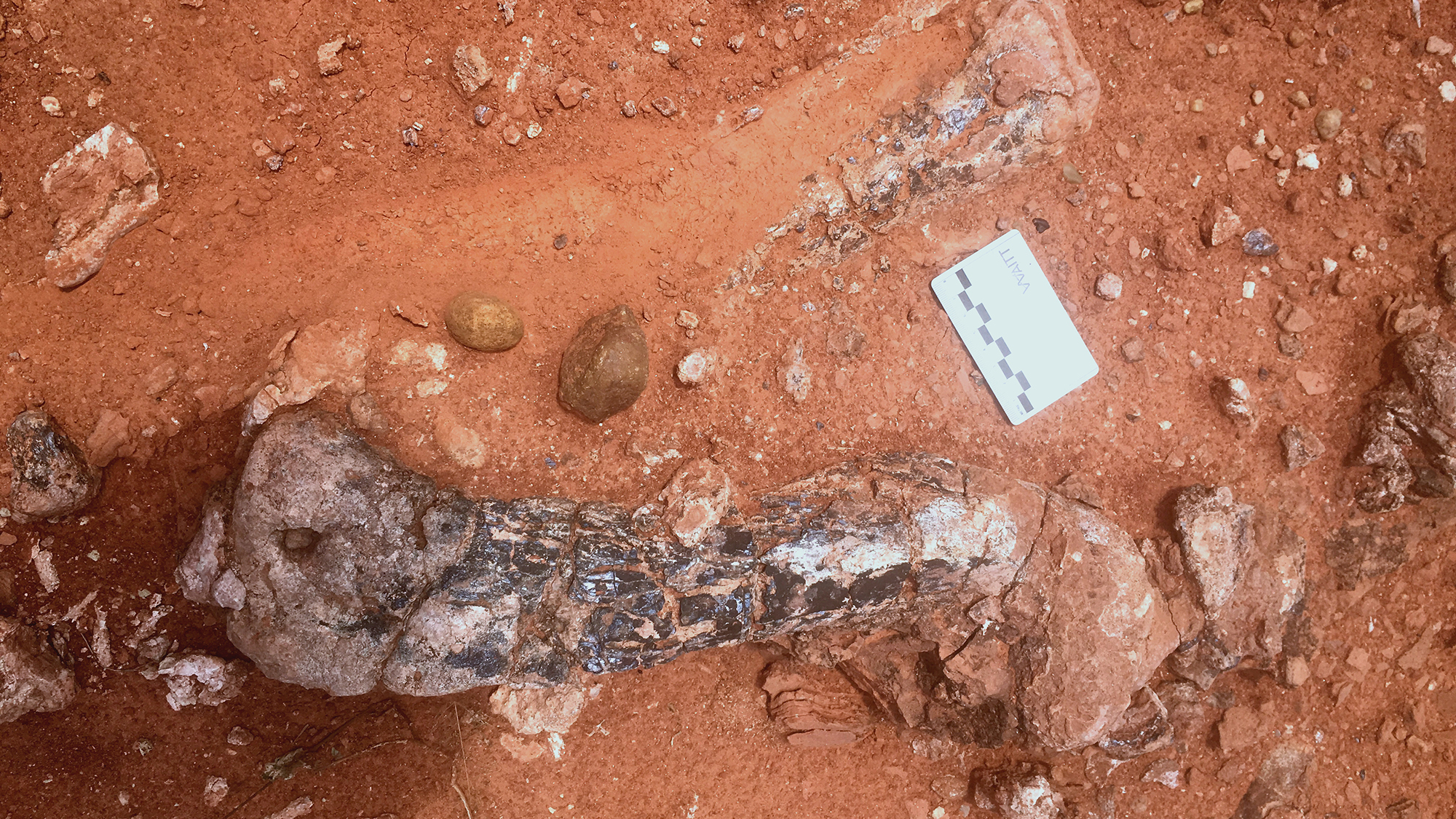

An international team of scientists uncovered a new species of dinosaur in Zimbabwe. The remains of a 210 million-year-old dinosaur leg that belonged to Musankwa sanyatiensis were discovered along the shore of Spurwing Island in Zimbabwe’s Lake Kariba. The new species is the fourth dinosaur species found in the southern African country and is described in a study published May 30 in the journal Acta Palaeontologica Polonica.
Based on the rocks where the new fossil was found, it lived during the Late Triassic period. During the Triassic, most of Earth’s major land masses were still together in the supercontinent Pangea. The climate was mostly warm and dry, with some seasonal monsoons.
“This species is pretty old, dating back to the Late Triassic when the dinosaurs were getting larger and starting to dominate ecosystems,” Paul Barrett, a study co-author and paleontologist from London’s Natural History Museum, said in a statement. “This is the time when they began to become more diverse and spread around the world, making it an important era to investigate.”
[Related: Zimbabwe’s newest dinosaur may be Africa’s oldest.]
The fossils were discovered during a 2018 expedition to northern Zimbabwe. A team of paleontologists from Zimbabwe and South Africa worked with teams from the United Kingdom and United States to see what they could find after local safari guides mentioned seeing something intriguing along the lake. The owners and crew of the houseboat Musankwa were provided the vessel as a sort of floating laboratory to help with the expedition.
Alongside a variety of fossils, including conifer trees, some ancient amphibians, and crocodile-like phytosaurs they. These fossils suggest Musankwa sanyatiensis would have lived along a swampy woodland region filled with water channels and dinosaurs among the trees.
They found a fossilized hind leg that belonged to Musankwa sanyatiensis. The remains include the dinosaur’s thigh, shin, and ankle bones.
“Despite the limited fossil material, these bones possess unique features that distinguish them from those of other dinosaurs living at the same time,” study co-author and Stony Brook University paleontologist Kimberley Chapelle said in a statement.
The fossil’s structure suggests that it was probably about five feet tall at the hips and was bipedal–two legged. Using estimates based on other sauropodomorphs of a similar size, the team believes that Musankwa sanyatiensis could have weighed about 850 pounds, roughly the same as a modern horse.
The name Musankwa sanyatiensis comes from the name of the houseboat that the team used. Musankwa means “boy close to marriage” in the Tonga dialect.
The discovery marks the first dinosaur named from the Mid-Zambezi Basin of northern Zimbabwe in over 50 years. While Africa has a long history of dinosaur discovery, most known dinosaur fossils have been uncovered in only 10 countries. Most of these countries are in the Northern Hemisphere, limiting African dinosaur representation in the fossil record.
Musankwa sanyatiensis also may have been part of a group of dinosaurs that lived across the African and South American and African land masses when they were connected.
“There was a hint from our evolutionary trees that it might be linked to Riojasaurus from Argentina and Eucnemesaurus from South Africa,” said Barrett. “It might mean these animals were a widespread, cosmopolitan group of dinosaurs able to move back and forth between what is now South America and southern Africa.”
[Related: A second asteroid may have crashed into Earth as the dinosaurs died.]
Remains of another Musankwa species might also be found elsewhere, a prospect that Barrett calls “tantalizing,” but needs more evidence to confirm.
The sediments in Zimbabwe dating back to the Late Triassic-Early Jurassic are critical for better understanding of the End-Triassic extinction. Around 200 million years ago, this catastrophic extinction event dramatically reshaped Earth’s biodiversity. The layers here provide insight into how the different fossil-bearing sediments around the planet correspond in age and help build a timeline and more detailed global picture of prehistoric life.
The team hopes that as more fossil sites in the area are explored, they will find more evidence that sheds light on the early evolution of dinosaurs and the ecosystems where they lived.
“Based on where it sits on the dinosaur family tree, Musanwka sanyantiensis is the first dinosaur of its kind from Zimbabwe,” said Chapelle. “It, therefore, highlights the potential of the region for further palaeontological discoveries,” she says.
